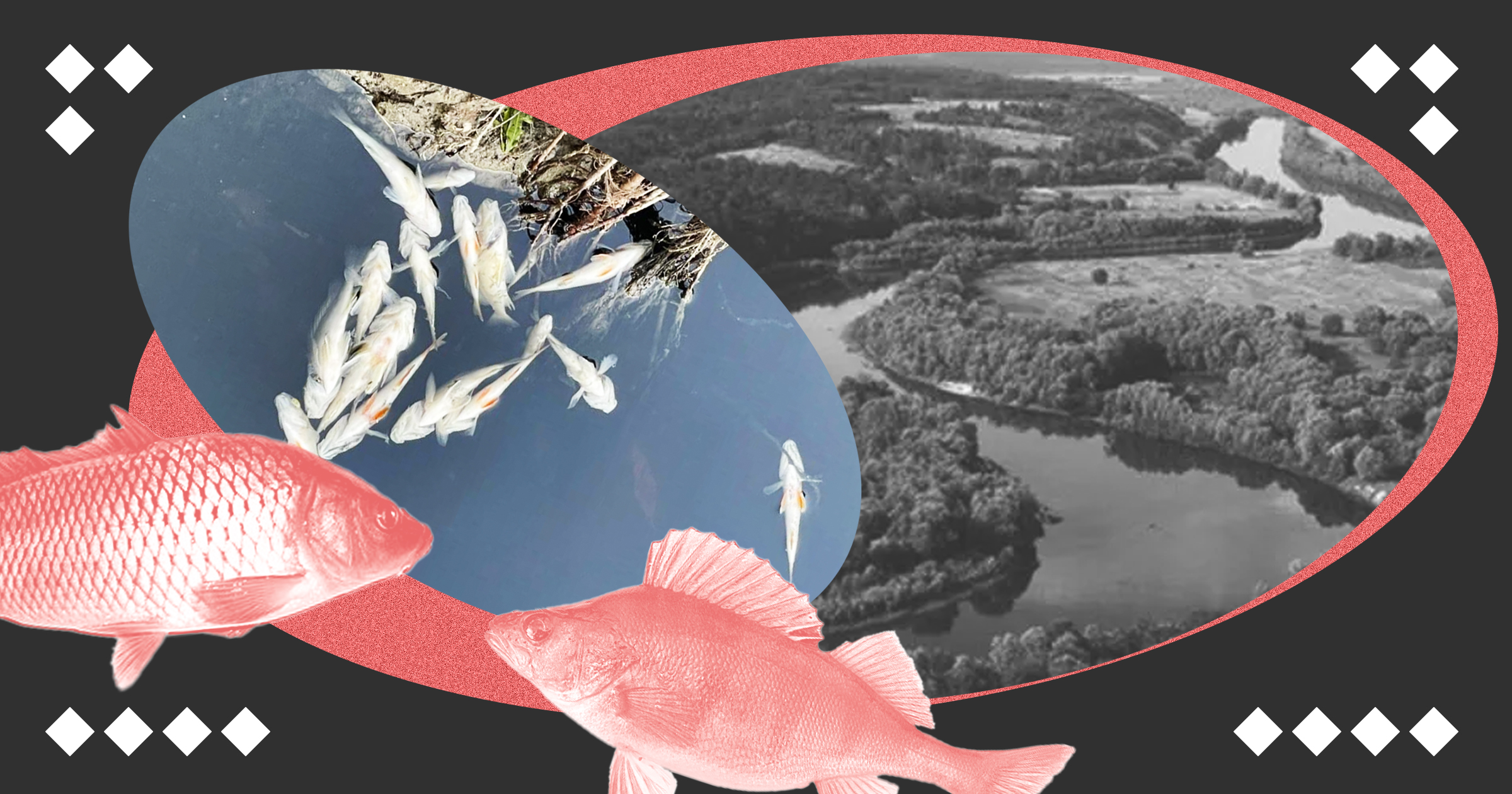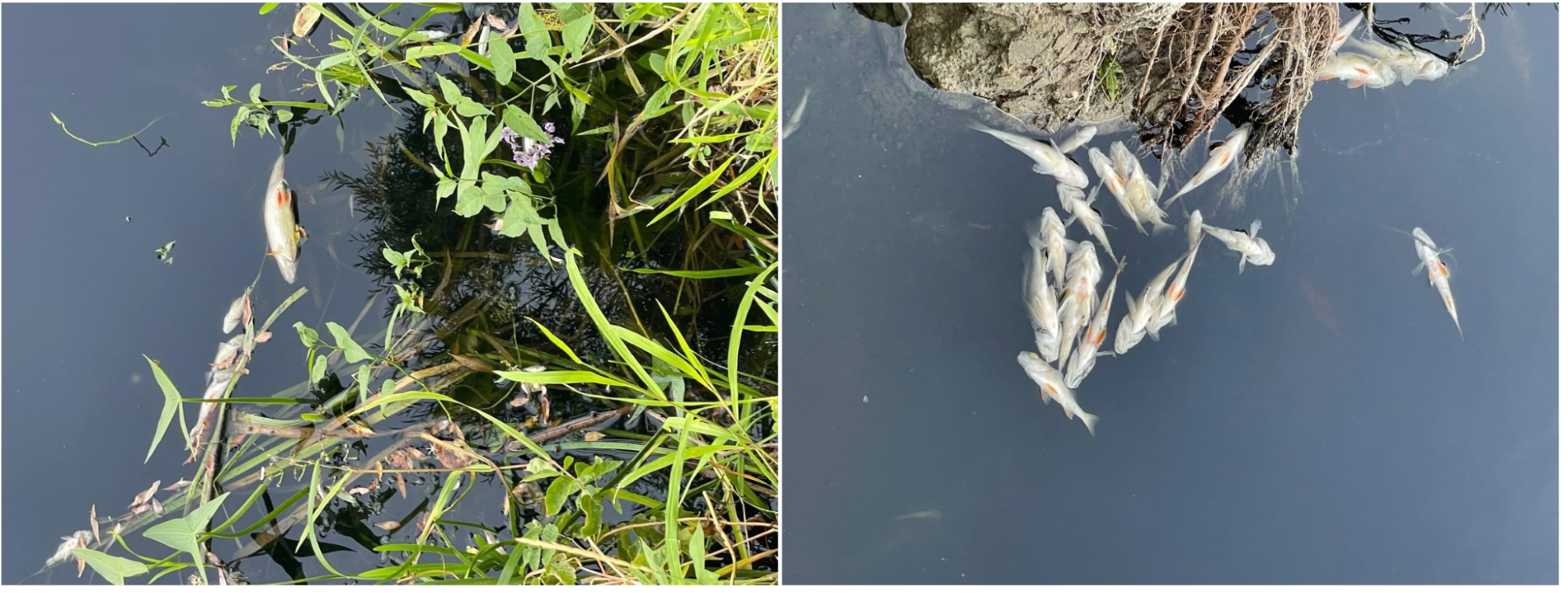Recent reports of a mass fish die-off in the Seim River have raised concerns in Ukraine. Damage to industrial facilities in bordering regions of Russia is likely the cause of this water pollution.


The Seim River flows through the Belgorod and Kursk regions in southwestern Russia, crossing into Ukraine's northern Sumy and Chernihiv regions before joining the Desna River. Recently, a mass fish die-off was reported in Ukraine's Seim, and tests revealed dangerously high levels of pollutants, including ammonia and suspended solids.
On August 27, the State Agency of Ukraine for Irrigation, Fisheries, and Food Programs reported that the fish deaths were caused by critically low oxygen levels in the water—less than 1 mg/l, compared to the minimum safe level of 4 mg/l. Organic substances that had entered the water led to this lack of oxygen.


Fish die-off in the Seym River. Source: State Agency of Ukraine for Irrigation, Fisheries, and Food Programs
The pollution has now spread throughout the entire section of the Seim River in the Sumy region and reached the Chernihiv region. Near the town of Baturyn, the water is black, smells of rot and ammonia, and is filled with dead fish. Oxygen levels remain critically low across the affected stretch of the river.
The Seim River is about 748 kilometers. Photo: Wikimedia Commons
Ukrainian law enforcement opened a criminal case to investigate the pollution at the initiative of the state fishery agency. According to the initial data, the likely cause is the release of pollutants on Russian territory.
The Sumy branch of the State Environmental Inspectorate reported that cloudy water near the Ukrainian-Russian border could indicate a discharge of unknown substances from Russian territory.
According to the inspectorate, hostilities in Russia's Kursk region have damaged sugar and alcohol factories and a leather factory in the town of Tyotkino. Since early August of this year, Ukraine launched an incursion into the area to push Russian forces shelling the Ukrainian regions away from the border. Waste from the facilities in Russian territory may have caused the pollution.
Ecologist and journalist Oleh Lystopad agreed with this theory in an interview with Hromadske Radio. He noted that this explanation is likely proper, as no large Ukrainian enterprises in the region could have released such a large amount of organic waste.
The Sumy Environmental Inspectorate also pointed out that it's currently impossible to pinpoint the exact source of the pollution because access to the upstream areas of the Seim for sampling is restricted due to war. These areas are either in a border zone with limited access or on Russian territory.
On August 28, Serhii Panchenko, a scientist from the Hetmanskyi National Nature Park that stretches along the floodplains and terraces on the right bank of the Vorskla River in the Okhtyrka area of the Sumy region, posted on the "Friends of Seim Landscape Park" Facebook page that while the Seim is beginning to recover, the restoration will be slow.
"The black silt is slowly settling. The water is becoming clearer, though the smell remains," said Panchenko. "The sand is covered in a layer of dark sludge, and sand is starting to cover it in faster-flowing areas. Silt also settles on aquatic plants, which play an important role in natural water filtration."
The scientist also noted that decomposition will continue at the bottom of the river, but if no more pollutants enter, oxygen depletion will gradually decrease. The rate of recovery will depend on water temperature.
"Over the winter, some of the polluted silt will break down, but algae and aquatic plants are expected to flourish in summer," Panchenko added. "Fish and crayfish may begin to repopulate from lakes and tributaries where they survived the disaster. It's best to avoid fishing to allow these populations to recover."
Patrols from the State Fisheries Agency and other government bodies are already working to mitigate the effects of the environmental disaster. They collect and properly dispose of dead fish, following all necessary sanitary standards. However, removing dead fish alone is insufficient, as the substances that caused the die-off also need to be neutralized.
"To help the river clean itself, it's important not to obstruct its flow. The river should meander freely, without artificial straightening, and the protective buffer zone along the shore must be maintained," said ecologist and journalist Oleh Lystopad. "There are plans to extract large amounts of sand from the Desna River for construction, which harms the river. It speeds up the current, preventing pollutants from settling out."
Serhii Panchenko also commented on proposed solutions, noting that not all of them should be put into practice. The first option is an active one: the introduction of special chemicals into the river.
"This would make the water clearer, but it could also kill off the remaining natural filters in the ecosystem. This solution might appeal to companies specializing in treating industrial or wastewater or maintaining fish ponds and swimming pools. But it's not suitable for the natural ecosystem of the SeIm," he said.
The second option is to improve the wastewater treatment facilities in the towns of Putyvl and Konotop, as well as in larger villages and industrial sites. Panchenko added that increasing the water flow from the Seym's tributaries is also important, even if it means draining certain ponds or irrigation systems.
Finally, the third option is to organize a comprehensive expedition along the Seim to assess the full scale of the disaster. Last year, specialists studied invertebrates in the river, so they have data for comparison. However, since the Seim flows through Russia, this option seems unlikely.
Is it safe to use the Seim for any purpose now? No. The Konotop District Commission on Environmental and Technological Safety and Emergency Situations has temporarily banned swimming, fishing, and the use of Seim water for household purposes in several communities in the Sumy region, including Nova Sloboda, Bochechky, Popivka, Buryn, Putyvl, and Krolevets. Similar restrictions are in place in the Baturyn community in the Chernihiv region. There have been no reports that the water quality has returned to normal.
The Desna River could've also been polluted by the Seim, which flows into it, but it wasn't. On August 28, the State Environmental Inspectorate of the Capital District reported no excess levels of organic or mineral substances in the Desna River in the Kyiv region. Oxygen levels are also standard, and no fish deaths have been observed.
Миколаїв, прифронтове місто з багатою історією суднобудування, сьогодні долає виклики війни — обстріли, дефіцит води… Читати більше
Partners of Ukrainian soldiers often face hardships and emotional struggles alone. Drawing from real stories,… Читати більше
Повномасштабне вторгнення спричинило руйнування й втрати, ускладнило розвиток і планування майбутнього. Проте економічне зростання –… Читати більше
“Рубрика” зібрала для вас статті, які, як, власне, і березень, кажуть: навіть у найскладніші часи… Читати більше
Першим кроком до того, щоб розпоряджатись своїми коштами грамотно, є планування бюджету. Як розрахувати кошти… Читати більше
Discover practical advice for parents of teens with ASD. Learn how to support your child… Читати більше
Цей сайт використовує Cookies.